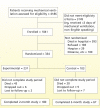Chronically critically ill patients: health-related quality of life and resource use after a disease management intervention
- PMID: 17724242
- PMCID: PMC2040111
Chronically critically ill patients: health-related quality of life and resource use after a disease management intervention
Abstract
Background: Chronically critically ill patients often have high costs of care and poor outcomes and thus might benefit from a disease management program.
Objectives: To evaluate how adding a disease management program to the usual care system affects outcomes after discharge from the hospital (mortality, health-related quality of life, resource use) in chronically critically ill patients.
Methods: In a prospective experimental design, 335 intensive care patients who received more than 3 days of mechanical ventilation at a university medical center were recruited. For 8 weeks after discharge, advanced practice nurses provided an intervention that focused on case management and interdisciplinary communication to patients in the experimental group.
Results: A total of 74.0% of the patients survived and completed the study. Significant predictors of death were age (P = .001), duration of mechanical ventilation (P = .001), and history of diabetes (P = .04). The disease management program did not have a significant impact on health-related quality of life; however, a greater percentage of patients in the experimental group than in the control group had "improved" physical health-related quality of life at the end of the intervention period (P = .02). The only significant effect of the intervention was a reduction in the number of days of hospital readmission and thus a reduction in charges associated with readmission.
Conclusion: The intervention was not associated with significant changes in any outcomes other than duration of readmission, but the supportive care coordination program could be provided without increasing overall charges.
Figures




References
-
- Chelluri L, Mendelsohn AB, Belle SH, et al. Hospital costs in patients receiving prolonged mechanical ventilation: does age have an impact? Crit Care Med. 2003;31(6):1746–1751. - PubMed
-
- Spillman BC, Lubitz J. The effect of longevity on spending for acute and long-term care. N Engl J Med. 2000;342(19):1409–1415. - PubMed
-
- Lassman D, McDonald E.Revenue for health care and social assistance up 4 percent, Census Bureau reports US Dept of Commerce News; Published February 7, 2001. http//www.census.gov/Press-Resease/www/2001/cb01-21.html Accessed June 29, 2007 Washington, DC
-
- Wagner DP. Economics of prolonged mechanical ventilation. Am Rev Respir Dis. 1989;140(2 pt 2):S14–S18. - PubMed
-
- Ely EW, Evans GW, Haponik EF. Mechanical ventilation in a cohort of elderly patients admitted to an intensive care unit. Ann Intern Med. 1999;131:96–104. - PubMed
Publication types
MeSH terms
Grants and funding
LinkOut - more resources
Full Text Sources
